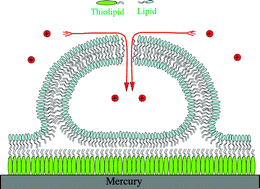Tethered bilayer lipid micromembranes for single-channel recording: the role of adsorbed and partially fused lipid vesicles
Abstract
A mercury-supported bilayer

* Corresponding authors
a
Department of Chemistry, Florence University, Via della Lastruccia 3, 50019 Sesto Fiorentino, Firenze, Italy
E-mail:
lucia.becucci@unifi.it, serena.cinotti@yahoo.it, guidelli@unifi.it
Fax: (+39) 055-457-3385
Tel: (+39) 055-457-3095
b
Department of Experimental Pathology and Oncology, Florence University, Viale G.B. Morgagni 50, 50134 Firenze, Italy
E-mail:
massimo.damico@unifi.it
c
Department of Physical Chemistry, Venice University, Calle Larga S. Marta 2137, 30123 Venezia, Italy
E-mail:
sig@unive.it
A mercury-supported bilayer

 Please wait while we load your content...
Something went wrong. Try again?
Please wait while we load your content...
Something went wrong. Try again?
L. Becucci, M. D'Amico, S. Cinotti, S. Daniele and R. Guidelli, Phys. Chem. Chem. Phys., 2011, 13, 13341 DOI: 10.1039/C1CP20667B
To request permission to reproduce material from this article, please go to the Copyright Clearance Center request page.
If you are an author contributing to an RSC publication, you do not need to request permission provided correct acknowledgement is given.
If you are the author of this article, you do not need to request permission to reproduce figures and diagrams provided correct acknowledgement is given. If you want to reproduce the whole article in a third-party publication (excluding your thesis/dissertation for which permission is not required) please go to the Copyright Clearance Center request page.
Read more about how to correctly acknowledge RSC content.
 Fetching data from CrossRef.
Fetching data from CrossRef.
This may take some time to load.
Loading related content
